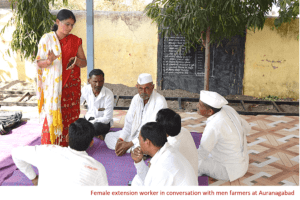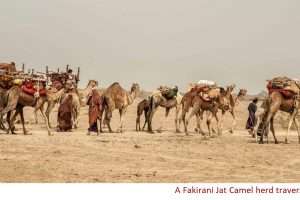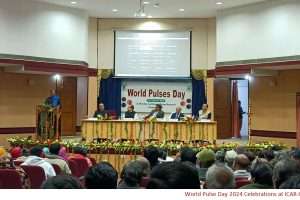There are several dichotomies which often interfere in the process of ‘making veterinarians’ and delivery of services by them. These dichotomies need correction for smooth functioning of veterinary institutions in the country and for producing quality veterinary graduates and postgraduates as per the requirement of different stakeholders, argue Dr S V N Rao, Dr P V K Sasidhar and Dr D Thammi Raju in this blog post.
 Dr S V N Rao retired as Professor and Head, Department of Veterinary and Animal Husbandry Extension Education, Rajiv Gandhi Institute of Veterinary Education and Research, Puducherry. (svnrao1953@gmail.com).
Dr S V N Rao retired as Professor and Head, Department of Veterinary and Animal Husbandry Extension Education, Rajiv Gandhi Institute of Veterinary Education and Research, Puducherry. (svnrao1953@gmail.com).
 Dr P V K Sasidhar is Director, School of Extension and Development Studies, Indira Gandhi National Open University (IGNOU), New Delhi-110068. (pvksasidhar@ignou.ac.in).
Dr P V K Sasidhar is Director, School of Extension and Development Studies, Indira Gandhi National Open University (IGNOU), New Delhi-110068. (pvksasidhar@ignou.ac.in).
 Dr D Thammi Raju is Principal Scientist, Education Systems Management Division, ICAR-National Academy of Agricultural Research Management (NAARM), Rajendranagar, Hyderabad-500 030. (dtraju@naarm.org.in).
Dr D Thammi Raju is Principal Scientist, Education Systems Management Division, ICAR-National Academy of Agricultural Research Management (NAARM), Rajendranagar, Hyderabad-500 030. (dtraju@naarm.org.in).





RESPONSE OF AUTHORS TO Datta Rangnekars comments: Dear Sir Thanks for your critical comments on our blog. Your concern for livestock based livelihoods is very valid and to some extent it has been taken care by including it in the new VCI syllabus. The course content is reproduced for your kind information . UNIT-1 (LIVESTOCK BASED LIVELIHOODS & ITS EVOLUTION) History of domestication and their social dimensions. Evolution and relationship between agriculture and animal husbandry. Farming and characteristics of farming in India. Classification of farming, types and systems. Peasant farming, cooperative farming, collective farming, contract farming, estate farming, organic farming, capitalistic farming, small-scale farming, large-scale farming, intensive, extensive farming, specialized, diversified, mixed, integrated and dry land farming. Role of animals in the contemporary society. Now it is for the extension faculty to deliver the goods. I expect that the faculty will do justice by providing good exposure to the students to enable them to understand the basic concepts on this topic. Second and the most important issue you have raised is feedback from the users of the output from the vety. institutions both research product and students (graduates and post graduates ). In this blog we suggested to the VCI to involve and obtain the views of all the stakeholders while revising the course curriculum, syllabus etc. Officials of AHD always feel that there is a gap between the training needs and the training we offer at the colleges. Regarding the low utility of research output development professionals like you have raised it on several platforms but unfortunately the needs of the livestock owners are not in the research agenda of our scientists. Your comments will be useful to me during my presentation in the forthcoming NAVS convention scheduled to be organised at SVVU, Tirupati on 5th Nov. Thanks once again for your critical comments. (SVN Rao)
Very Interesting. There are many other dichotomies (if that is the framework to discuss the issues). The dichotomy of focus by policy makers and government on crop production vs animal production whereas in Indian agriculture they are deeply interwoven. The focus on ambulatory medicine rather than animal health with epidemiology, herd and flock health and preventive medicine finally considering one health principles. We cannot continue to look at anything to do with agriculture in a framework set in 1950s in 2025.
Dr. Rangnekar through CRISP raises very valid points. There is a greater equity in livestock ownership than land ownership. Yet, we pay no attention to this as an opportunity for poverty alleviation and tailor our education systems to this. Our focus is ambulatory medicine. We hold cattle infertility camps which have very little real impact but invest almost nothing in systemic preventive medicine and animal health, disease surveillance and teaching and practicing veterinary epidemiology. To me our greatest dichotomy is that while we know a lot about our real agricultural and farming systems, we continue to follow models developed for USA taught to us when we trained a lot of our teachers under PL 480 in the 1960s-70s.
Thanks for mailing Blog 73 – on study of Dichotomies in Vet. education and as expected the authors have done an excellent job of analysing dichotomies. On studying the blog and considering the dictionary meaning of Dichotomy (Division into two parts when these are sharply distinguished or opposed) I felt there are a few more Dichotomies that could have been considered, analysed and policy implications indicated – I mention the major ones below: India has highest number of families dependent on livestock for livelihood and Livestock production development is now considered a major intervention tool for livelihood development. The Dichotomy is that the subjects that will enable good understanding of livestock production and its development from a livelihood perspective i.e Economics, Sociology, Extension, Communication (Soft Sciences) are neglected in teaching as well as research. Basic understanding/awareness of these subjects by Vet graduate/PGs will enable them to work contribute to livestock development more effectively. In the same way a Glaring Dichotomy exists in planning and implementing Livestock Research and Technology Development (I wish the authors would have analysed situation regarding Research). The Dichotomy is that most research recommendations and technologies are High Input Based while it is known that majority of livestock producers are small holder resource poor families and follow Low External Input Based System. It is also a fact that most of research recommendations and technologies are poorly adopted by livestock producers. There is a case for Paradigm Shift in planning and implementation of livestock research and technology development. This raises a question – why these organisations do not try to find out extent of acceptance of their products viz. research recommendations, technologies and graduates and post – graduates (by getting feed back from the users of the products).
Very well written blog, which addresses very important issues concerned with veterinary education in India. It speaks about the authors depth of understanding on the subject-congratulations to Drs SVN Rao, Sasidhar & Thammiraju. I see paravets often develop expertise beyond their mandated domains due to practice, while many vets due to lack of practice are not able to perform in the field inspite of all the qualification/degrees they have. It is because of regular practice these paravets get skilled in handling the cases (though not entitled), so farmer demand their services and call them DOCTORS, while many vets avoid handling cases themselves (there are reasons like the equipment are lacking in many hospitals in several states). I am reminded of the article written by Menaka Gandhi, which is relevant here.